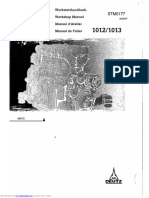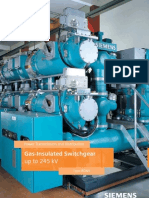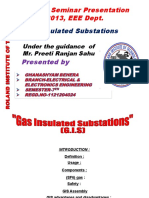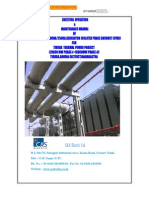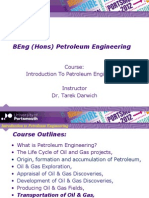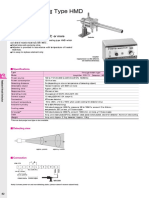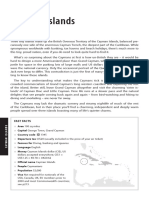GIS 8DN9 Ds e
GIS 8DN9 Ds e
Uploaded by
Ashish JainCopyright:
Available Formats
GIS 8DN9 Ds e
GIS 8DN9 Ds e
Uploaded by
Ashish JainOriginal Title
Copyright
Available Formats
Share this document
Did you find this document useful?
Is this content inappropriate?
Copyright:
Available Formats
GIS 8DN9 Ds e
GIS 8DN9 Ds e
Uploaded by
Ashish JainCopyright:
Available Formats
Answers for energy.
siemens.com/energy
Gas-insulated switchgear
up to 245 kV, 50 kA, 4000 A
Type 8DN9
Gaining from experience
Our switchgear ensures extraordinarily high availability with low operating costs.
2
The Siemens gas-insulated switchgear (GIS) is an
extremely successful product concept. Since its
introduction back in 1968, Siemens has installed more
than 28,000 indoor and outdoor switchgear bays world-
wide, and well over 300,000 bay-years of operation have
been recorded. Intense research and continuous further
development of the first system types have led to todays
generation of gas-insulated, metal-encapsulated switch-
gear a world leader in terms of
Economic efficiency
High reliability
Safe encapsulation
High degree of gastightness
Long service life
Low life-cycle and maintenance costs
Easy access and ergonomic design
High availability
Reliable operation even under extreme environmental
conditions
All requirements that are nowadays usually specified for
modern and advanced switchgear in terms of performance
and reliability are met by our 8DN9 switchgear for rated
voltages of up to 245 kV. They are among the most
compact designs available worldwide. This compact
design has become possible through the use of improved
insulating materials, the optimization of the enclosure
form, and utili zation of computer-aided design methods
in conjunction with modern casting techniques and
improved manufacturing technology.
The space-saving design, low weight, and long operating
life plus low operating costs contribute to making this
switchgear extremely economical. Since the levels of
noise and field emission (EMC) are extremely low, it is
possible to integrate this switchgear even in sensitive
environments, residential quarters, and city centers.
Thanks to its excellent charac teristics, our 8DN9 switch-
gear fulfills all the requirements for environmentally
compatible high-voltage switchgear.
3
Flexibility thanks to modular design
The conductors are linked by coupling contacts capable of
absorbing movements due to thermal expansion. Where
necessary, the joints are acces sible via openings which
are closed with gastight and pressure-resistant covers.
Sulphur hexafluoride (SF6) is used as insulating and
arc-quenching me dium. Any moisture or decomposition
products are com pletely absorbed by static filters in the
gas compartments, which are attached to the inside of
the covers of the access openings. Rupture diaphragms
prevent build-up of an impermissible high pressure in the
enclosure. A diverter nozzle on the rupture diaphragm
ensures that the gas is expelled in a de fined direction in
the event of bursting, thus en suring that the operating
personnel are not en dan gered. SF6 is completely sealed in
and will not be consumed. Thus, with proper use there is
no environ mental danger.
A fundamental feature of our gas-insulated switchgear
is the high degree of versatility provided by a modular
system. According to their respective functions, the
components are arranged in pressure-resistant gastight
enclosures. With a remarkably small variety of active
and passive modules, it is possible to meet all customary
bus schemes.
8DN9 type switchgear benefits from the advantages of
single-phase and three-phase encapsulation. Single-phase
encapsulation in the feeder and three-phase encapsula-
tion in the busbar enables an extremely compact design
with reduced space requirements.
The cast-aluminum enclosures ensure a lightweight and
corrosion-resistant system. Modern forming and casting
techniques made possible the optimization of the dielectric
and mechanical characteristics of the enclosure. The low
bay weight results in minor floor load. The flanges at all
module joints are equipped with high pressure O-ring seals
to ensure high gastightness.
4
2 14 3 5 4 6 7 10 9 12
1 11 8 13
1. Circuit-breaker interrupter unit
2. Stored-energy spring mechanism
with circuit-breaker control unit
3. Busbar I
4. Busbar disconnector I
5. Busbar II
6. Busbar disconnector II
7. Work-in-progress earthing switch
8. Work-in-progress earthing switch
9. Outgoing-feeder disconnector
10. Make-proof earthing switch
(high-speed)
11. Current transformer
12. Voltage transformer
13. Cable sealing end
14. Integrated local control cubicle
With only a few modules, all typical switching configurations can be created.
Gastight bushings
Gas-permeable bushings
11
M
M
M
M
M
8
7
4 6
3
5
9
12
10
13
1
14
5
Circuit-breaker module
Circuit-breaker module
The central element of a switchgear bay within the gas-
insulated switchgear is the single-phase encapsulated
circuit breaker. The circuit breaker is designed for single-
pole automatic reclosure. It consists of two main
components:
Interrupter unit
Stored-energy spring mechanism
The design of the interrupter unit and the spring mecha-
nism is based on time-tested identical constructions
widely used in air-insulated as well as gas-insulated
switching technology for many years. This design,
decades of experience, and high quality guarantee the
surpassing reliability of our switchgear.
Stored-energy spring mechanism
The stored-energy spring mechanism provides the force
required to operate the circuit breaker. It has a compact,
corrosion-free aluminum housing. Both the opening and
the closing spring are visibly arranged within the drive
unit. The complete drive unit is strictly separated from the
SF6 compartment. Roller bearings and the maintenance-
free spring mechanism ensure decades of reliable opera-
tion. Proven technology, such as vibration-isolated latches
and load-free isolation of the charging mechanism,
improve the reliability of the mechanism.
The advantages of the stored-energy spring mechanism:
Identical construction principle for rated voltages from
72.5 to 550 kV
Low operating energy
Simple principle of operation
Switching state controllable at all times
Low maintenance, economical with a long service life
1
2
3
4
5
6
7
8
9
10
11
12
13
14
15
16
17
9. Charging mechanism
10. Charging shaft
11. Roller lever
12. Closing damper
13. Operating shaft
14. Opening damper
15. Opening release
16. Mechanism housing
17. Opening spring
1. Closing release
2. Cam plate
3. Coupling linkage
4. Operating rod
5. Closing spring
connecting rod
6. Opening spring
connecting rod
7. Closing spring
8. Hand-wound
mechanism
6
Interrupter unit
The interrupter unit used in the circuit breaker for arc-
quenching operates according to the dynamic self-
compression principle. This principle requires only little
operating energy, which keeps the mechanical stresses
on the circuit breaker and its housing as well as the foun-
dation loads to a minimum.
Current path
In the closed position, the operating current flows
through the contact finger (2) and the contact cylinder
(10). The arcing contacts (1, 7) are connected in parallel
to the main contacts.
Interruption of operating current
During the breaking operation, the contact finger (2)
with the contact cylinder (10) opens and the current
commutates to the arcing contacts (1, 7), which are still
closed. This avoids erosion of the main contacts. As the
breaking operation continues, an arc forms between the
contacts (1) and (7). At the same time, the contact cylin-
der (10) compresses the SF6 gas located in the compres-
sion volume (4). The compressed arcquenching gas flows
through the heating volume (11) into the contact gap and
extinguishes the arc.
Interruption of fault currents
In the case of large short-circuit currents, the gas between
the arcing contacts (1) and (7) is heated by the arc energy.
Thus, the pressure in the heating volume (11) increases.
When the current passes through zero, the gas flows back
from the heating volume (11) through the nozzle (9) and
quenches the arc. The valve (3) of the contact cylinder
(10) prevents the high-pressure gas from entering the
compression volume (4). Thus, the operating mechanism
does not have to supply the arc-quenching energy.
1. Moving arcing contact
2. Main contact
3. Check valve
4. Compression volume
5. Check valve
6. Steering gear
Arc-quenching principle
Breaking:
main contact opened
Breaker in
On position
Breaker in
Off position
Breaking:
arcing contact opened
7. Moving arcing rod
8. Insulating nozzle
9. Auxiliary nozzle
10. Contact cylinder
11. Heating volume
5
4
3
2
1
11
10
9
8
7
6
7
Disconnecting switches
In the open position, disconnecting switches assure a
dielectrically safe gap between system parts at different
potentials; for example, the busbar disconnector isolates
the feeders from the busbar. Cast-resin bushings keep the
contact system in place, and the pressurized gas serves as
the high-voltage insulating medium between live parts
and the metal housing.
The conductor terminals vary for different types of
adjacent modules. Up to two earthing switches can be
installed simultaneously. The disconnecting switches can
be built as separate gas compartments with their own
monitoring or be combined with surrounding modules.
Earthing switches
Earthing switches (work-in-progress earthing switches or
busbar earthing switches, for example) are used for
properly connecting de-energized live parts of the high-
voltage system to the grounding system. On the outgoing
side of the feeders, a make-proof version (high-speed) is
frequently used to dissipate inductive and capacitive
currents from parallel cables or overhead lines or to
reduce the risk to the GIS system in case of faulty con-
nections. In the insulated design they are also used for
measuring purposes and for testing protection relays.
In the switchgear type 8DN9 up to 245 kV, the earthing
switches are of a pin-type design. Depending on the
switchgear design, they are either incorporated in a
common housing with the disconnection switches or
installed in a separate housing. With the pin-type earthing
switch, the earthing pin at earth potential is pushed into
the matching contact. Make-proof earthing switches are
equipped with a stored-energy spring mechanism. The
spring, which stores the required switching energy, can
be recharged either with a motor or manually in an
emergency.
Surge arrester
If desired, encapsulated surge arresters can be connected
directly. Their purpose is to limit any overvoltages.
Their active parts consist of metal-oxide resistors with a
strongly non-linear current/voltage characteristic. The
arrester is generally flange-jointed to the switchgear via a
gastight bushing that is included with the delivery. An
inspection hole in the arrester housing allows opening the
internal conductor when inspecting the switchgear. The
connections for gas monitoring, arrester testing, and a
surge counter are at the bottom.
Disconnecting switch
Pin-type earthing switch
Surge arrester
Common features of disconnecting and earthing
switches
The three poles of a bay are coupled mechanically
All three poles are commonly operated by one
motor drive
Alarm switches and ON/OFF indicators are
friction-locked and directly connected to the
drive shaft
Identical motor drives are used for disconnecting
and earthing switches
Manual emergency operation is integrated
Enclosures can be fitted with inspection windows
on request
8
Instrument transformers
Both current and voltage transformers are used for
measuring and protection purposes.
Current transformer
The current transformers are of the single-phase inductive
type with one or more cores and preferably located on
the outgoing side of the circuit breaker. They can, how-
ever, be located at any point within the bay or substation.
The high-voltage conductor forms the primary winding.
The cores with the secondary windings are located on a
grounded electrode and are designed to comply with the
requirements in terms of accuracy, class, and power
rating. Different ratios can be achieved via taps in the
secondary win ding. Secondary connections are routed
through a gastight bushing plate to a terminal box. The
pressu rized SF6 gas in the module serves as the primary
insulation. The encapsulated design provides very high
reliabi lity in terms of electromagnetic compatibility (EMC).
Voltage transformer/RC-voltage divider
Each single-phase inductive voltage transformer is encap-
sulated in its own housing and thus forms a separate
gas-tight module. Each voltage transformer consists of
the following main components:
The primary winding
One or more secondary windings (forming one coil)
An iron core
The pressurized gas inside the enclosure in combination
with the film insulation provides insulation against high
voltage. The high-voltage connection to the switchgear is
established via the primary conductor, which is supported
by a gastight bushing. The secondary connections are
routed via a gastight bushing plate to the terminal box.
Resistive-capacitive voltage dividers (RCVD) consist of
oil-impregnated capacitive elements with parallel
mounted resistors in hermetically-sealed glass-fiber-
reinforced plastic tubes (GRP). The RCVD has a common
gas compartment with the neighboring gas compartment.
It is also available in another version with a separate gas
compartment. The secondary connection can either be
designed as a single or as a double unit (redundant
version). The RCVD has a smaller size and weight in
comparison to inductive voltage transformers. It is a
ferroresonance-free technology with no saturable cores.
The RCVD maps high voltage in linear form over a wide
frequency range from DC up to 20 kHz and has an
excellent transient characteristic. The power output is low
but sufficient for the demands of modern protection and
energy counting systems (e.g. SIPROTEC 5).
Example: conventional
current transformer
Conventional voltage
transformer
RC voltage divider
9
Termination modules
The termination modules connect the bays of the gas-
insulated switchgear to the following items of equipment:
Cables
Overhead lines
Transformer or reactor
They form the transition between the GIS with SF6 gas
insulation and other high-voltage systems with different
insulating media.
Cable termination
This module acts as a link between the metal-enclosed
gas-insulated switchgear and the high-voltage cable.
All types of high-voltage cables complying with
IEC 62271-209 can be connected. The inspection hole
also provides the connecting flange for the high-voltage
cable testing set. During high-voltage cable testing, the
primary conductor between the cable sealing end and
the switchgear can be removed.
SF6 / air termination
The SF6 / air termination module enables the connecting of
the gas-insulated switchgear to air-insulated components
or overhead lines by means of a bushing, which is
available either as a porcelain or a composite insulator.
This termination is a combination of an angle-type
module and an SF6 bushing. The length, shed form, and
creepage distance of the outdoor/SF6 bushing can be
adapted to various requirements with regard to insulation
coordination, minimum clearance, or degree of pollution.
Transformer termination
The transformer termination module enables a direct tube
connection from the GIS to an oil-insulated transformer
or reactor. For this purpose, the transformer bushing
must be oil-tight, gastight, and pressure-resistant.
Temperature-related movements of the switchgear and
the transformer as well as the settling of foundations are
absorbed by expan sion joints in the tube connection
(acc. to IEC 61639/IEC 62271-211).
Cable termination
Transformer tube termination
SF6 / air termination
10
Busbar module
The switchgear type 8DN9 up to 245 kV has a three-phase
encapsulated passive busbar. The busbar modules of
adjacent bays are connected with expansion joints which
absorb constructional tolerances and tem perature-related
movements in longi tudinal as well as transverse direction
to the busbar. Axially guided sliding contacts between
the conductors compensate for temperature-related
expansions in conductor length. A sectionalizer (to
increase the availability of the switchgear) can be fitted
without any additional measures.
Connecting modules
These single-pole enclosed modules are used for connec-
tions required within a bay and / or for gas-insulated
busducts. The following connection mod ules can be
employed depending on the circuit and the special layout
of the bay:
Extension modules
T-modules
Angle-type modules
Expansion-joint modules
Design versions T-modules
Design versions angle-type modules
Extension module
Busbar module
T-module
T-modules are used as a junction or for the
connection of an earthing switch. Although
they are available in different designs, the
basic structure is always the same.
Angle-type module
Angle-type modules are used for the
splitting of the conductors into terminal
leads. They are available with 30, 45,
60, and 90 angles.
11
Control and monitoring
a reliable and flexible control
and protection system
Proven switchgear control
Robust electrical components are used to control and
monitor the circuit breaker as well as other switchgear
components.
All elements necessary for the control and moni toring of
circuit-breaker, disconnecting, and earthing switches are
incorporated in the respective control unit. The switching
device control systems are factory-tested, and the switch-
gear is usually supplied with bay-internal cabling all the
way to the integrated local control cubicle to reduce
commissioning time to a minimum and to avoid any
failures on-site.
Gas monitoring
Gastight insulating partitions subdivide each switchgear
bay into separate gas compartments (e.g., cir cuit breakers
with current transformer, discon nec ting switches, voltage
transformers, surge arresters, and termination modules).
The gas compartments are constantly monitored by density
monitors pro viding alarm and blocking signals via contacts.
Monitoring takes place on a triple- pole decentralized basis.
Reliable and flexible control and protection system
Control and feeder protection are generally accommodated
in the local control cubicle, which is itself integrated in the
operating panel of the switchgear bay. This substantially
reduces the amount of space required and also the time
needed for commission ing. If requested, a version of the
local control cubicle is available for installation separate
from the switchgear. The cabling between the separately
installed local control cubicle and the high-voltage
switching devices is connected up via coded plugs, which
minimizes both the costs of installation and the risk of
cabling failures.
On request, we can supply our high-voltage switchgear
with any of the commonly available digital control and
protection systems.
Standard interfaces in the local control allow the
connection of
Conventional control systems with protective
interlocking and control panels
Digital control and protection systems with user-
friendly bay controllers and station automation with
PC workstations (HMI)
Intelligent, fully networked digital control and protec-
tion systems with additional monitoring and remote
diagnostic functions
Thanks to the extensive range of Siemens control and
protection systems, we can offer you a wide range of
customized concepts from a single source.
Control cubicle with circuit-breaker operating
mechanism
12
Transport, installation,
commissioning, maintenance
Transport
To facilitate easy transport and on-site installation, our
switchgear assemblies are split into optimized shipping
units with emphasis on ease of handling. Standard
switchgear bays are usually shipped in one transport. All
shipping units are mechanically and dielectrically tested
before dispatch. In the case of modules that contain
switching devices, all operating-mechanism attachments
are preset at the factory prior to shipment. All flanges
where the modules join to other equipment are protected
against corrosion and sealed with transport covers.
All components are packed according to means, duration,
and route of transport as well as the conditions and
duration of storage. Shipments within Europe are normally
sent by road. Switchgear supplied to countries overseas
are sealed in appropriate shipping units with seaworthy
packing, taking into account any temporary storage that
may be necessary.
On-site installation
Dividing the switchgear into a few, easy-to-handle ship-
ping units reduces the time and effort required for
installation on site. Detailed installation instructions and
relatively few special tools allow easy and rapid installa-
tion of the switchgear. It can even be performed by your
own personnel under the supervision of an experienced
supervisor from Siemens. Our training facilities are at your
disposal if needed.
Commissioning
After completion of the assembly work on-site, all switching
devices and electrical circuits for controlling and monitoring
are tested to ensure the accurate electrical and mechanical
functioning of the entire system. All flanges are double-
checked for tightness. Commissioning work on the primary
section ends with the high-voltage test on site to verify that
all installation work has been conducted correctly. All tests
are performed in accordance with IEC standards and the
results are documented in the final test reports.
Maintenance
Our gas-insulated switchgear installations are designed
and manufactured to provide an optimal balance of
design, materials used, and maintenance measures.
Thanks to the hermetically sealed enclosure, a minimum
of maintenance is needed and the GIS system can even be
regarded as maintenance-free under normal operating
conditions. Depending on environmental conditions,
visual inspections are recommended. A visual inspection
is performed bay by bay, with no need for an outage or
opening the gas compartments. The first major inspection
is not due for 25 years.
13
A consistent quality management system supported by our
employees makes sure that we produce high-quality
gas insulated switchgear. The system was certified in 1983
in accordance with CSA Z299 and again in 1989 according
to DIN EN ISO 9001. The quality management system is
subject to continual improvement. Certification according
to DIN EN ISO 9001:2000 was passed with flying colors in
2003. As early as 1994, the environmental protection
system according to DIN EN ISO 14001 was implemented
as an addition to the existing quality management system
and successfully certified. One of the fundamental
milestones in developing testing competence was the
certification of the test labs according to ISO/IEC 17025
(previously EN 45001) in 1992 and the accreditation as
an independent PEHLA test lab.
The quality management and environmental protection
systems cover every single process in our products life
cycles, from marketing to after-sales service.
Regular management reviews and internal audits of all
processes based on the consistent documentation of all
processes relevant to quality and environmental protection
ensure that the system is efficient and up-to-date at all
times and that appropriate measures are taken to
continually improve it. Consequently, the quality of our
switchgear meets even the highest requirements.
In addition to consistent quality management and
environmental protection, the special clean areas set
up in the production workshops are an important
contribution to the high quality of our gas-insulated
switchgear.
Comprehensive manufacturing inspections and routine
testing of individual components, subassemblies, and
entire modules all play an important role in ensuring the
reliable operation of the overall product. Mechanical
routine and high-voltage tests of the complete bay or
complete shipping units verify that the manufactured
quality complies with the standards. Appropriate packing
ensures the switchgears safe arrival at its destination. High-voltage testing of a complete transport unit
Quality assurance
14
The modular system not only accomodates all customary
circuit arrangements but also individual solutions for
specific building dimensions, system extensions, and
much more.
M
M
M
M
M
M
M
M
M
Double busbar arrangement
Single busbar arrangement
Switchgear bay examples
3
4
7
0
4500
4740
3
4
7
0
1
5
0
0
15
3580
2
6
7
0
M
M
M
M
5300
3
4
7
0
M
M M
M
M
M
5490
3
8
0
0
Double busbar arrangement with transfer bus
Double busbar arrangement with bypass
Bus coupling arrangement
M M
M
M
M
M
16
Technical data Technical data
Switchgear type 8DN9
Rated voltage up to 245 kV
Rated frequency 50/60 Hz
Rated short-duration power-frequency withstand voltage (1 min) up to 460 kV
Rated lightning impulse withstand voltage (1.2 / 50 s) up to 1,050 kV
Rated normal current busbar
Rated normal current feeder
up to
up to
4,000 A
4,000 A
Rated short circuit-breaking current (< 3 cycles) up to 50 kA
Rated peak withstand current up to 135 kA
Rated short-time withstand current (up to 3 s) up to 50 kA
Leakage rate per year and gas compartment (type-tested) < 0.1%
Driving mechanism of circuit breaker stored-energy spring
Rated operating sequence
O-0.3 s-CO-3 min-CO
CO-15 s-CO
Bay width 1,500 mm
Bay height, depth (depending on bay arrangement) 3,700 mm x 5,100 mm
Bay weight (depending on bay arrangement) 7.5 t
Ambient temperature range 25 C up to +55 C
Installation indoor
First major inspection > 25 years
Expected lifetime > 50 years
Standards IEC / IEEE / GOST
Other values on request
17
Published by and copyright 2014:
Siemens AG
Energy Sector
Freyeslebenstrasse 1
91058 Erlangen, Germany
For more information, please contact
our Customer Support Center.
Phone: +49 180 524 70 00
Fax: +49 180 524 24 71
(Charges depending on provider)
E-mail: support.energy@siemens.com
High-voltage products
Order No. E50001-G630-A241-X-4A00
Printed in Germany
Dispo 30002
fb 5777 W WS 01142.0
Printed on elementary chlorine-free
bleached paper.
All rights reserved.
Trademarks mentioned in this document
are the property of Siemens AG, its affiliates,
or their respective owners.
Subject to change without prior notice.
The information in this document contains
general descriptions of the technical options
available, which may not apply in all cases.
The required technical options should therefore
be specified in the contract.
You might also like
- Food Festival Scope StatementDocument2 pagesFood Festival Scope StatementOti M. Richie0% (1)
- Price and Technical Comparison of AIS V GISDocument19 pagesPrice and Technical Comparison of AIS V GISNazmul HasanNo ratings yet
- Deutz Manual bf4m1012Document490 pagesDeutz Manual bf4m1012Elvis Astorayme GalvezNo ratings yet
- Sample of PASS M0 SBB - Installation Manual - 2GJA700101 (E)Document34 pagesSample of PASS M0 SBB - Installation Manual - 2GJA700101 (E)dwas1314No ratings yet
- The Technology of Instrument Transformers: Current and Voltage Measurement and Insulation SystemsFrom EverandThe Technology of Instrument Transformers: Current and Voltage Measurement and Insulation SystemsNo ratings yet
- Gas Insulated SwitchgearDocument118 pagesGas Insulated SwitchgearMA Ahmed100% (11)
- Technical Schedule of Surge Arrester 400 KV - ABBDocument5 pagesTechnical Schedule of Surge Arrester 400 KV - ABBmohammadkassarNo ratings yet
- Post-Task HistoryDocument1 pagePost-Task HistoryJoshua HongNo ratings yet
- The Snowman Cometh v1.1Document6 pagesThe Snowman Cometh v1.1Ваня РиковNo ratings yet
- GIS Type Series 8DN8Document20 pagesGIS Type Series 8DN8Vishal Narkhede100% (1)
- ELK-3 - 420 - 1HC0029799AGEn 420kV GISDocument0 pagesELK-3 - 420 - 1HC0029799AGEn 420kV GISMohammed NazeeruddinNo ratings yet
- Disconector SwicthDocument147 pagesDisconector SwicthjdzarzalejoNo ratings yet
- GIS Modules DE PDFDocument49 pagesGIS Modules DE PDFSrinivas K VamanamurthyNo ratings yet
- Sample of PASS M00 - SBB - Installation Manual - 2GJA700060 (E)Document32 pagesSample of PASS M00 - SBB - Installation Manual - 2GJA700060 (E)dwas1314100% (2)
- Huawei Access Network (Marijo Karabaic)Document27 pagesHuawei Access Network (Marijo Karabaic)Anonymous 0WWZi8Ia37No ratings yet
- Means of Achieving Strategies 6Document6 pagesMeans of Achieving Strategies 6Jobby Jaranilla50% (2)
- 2 2 1 1 2 4 Katalog-Z-Vvn-Rozv-8dn9-Gis-En 2000001263234Document18 pages2 2 1 1 2 4 Katalog-Z-Vvn-Rozv-8dn9-Gis-En 2000001263234Dante FilhoNo ratings yet
- 145kV GIS Catalog E 0810Document28 pages145kV GIS Catalog E 0810Ahmed BadrNo ratings yet
- Gis 145kv 4Document18 pagesGis 145kv 4tafseerahmedNo ratings yet
- Shashi Om Katiyar NTPC ConsultantDocument55 pagesShashi Om Katiyar NTPC Consultant2K20CEEE23 Nishi Kant KumarNo ratings yet
- 161kV GIS SDF120 (EEC 58-8f) 06B1-E-0001Document6 pages161kV GIS SDF120 (EEC 58-8f) 06B1-E-0001mersiumNo ratings yet
- Siemens GISDocument18 pagesSiemens GISimtiaz5100% (1)
- Gas Insulated Switchgear For High Voltage Substations SiemensDocument10 pagesGas Insulated Switchgear For High Voltage Substations SiemensLandon MitchellNo ratings yet
- Gas-Insulated Switchgear: Type 8DN8 Up To 170 KV, 63 Ka, 4000 ADocument33 pagesGas-Insulated Switchgear: Type 8DN8 Up To 170 KV, 63 Ka, 4000 APélagie DAH SERETENONNo ratings yet
- Gis Elk-04Document52 pagesGis Elk-04Richard GriffithNo ratings yet
- 00-Different SIEMENS GIS TypesDocument44 pages00-Different SIEMENS GIS TypesPélagie DAH SERETENONNo ratings yet
- Air-Insulated Medium-Voltage Switchgear NXAIR and NXAIR MDocument48 pagesAir-Insulated Medium-Voltage Switchgear NXAIR and NXAIR MGanesh Duraisamy100% (1)
- Elk-3 420 1HC0029799 Aj21 enDocument20 pagesElk-3 420 1HC0029799 Aj21 enaalbaki1No ratings yet
- Gas Insulated Switchgear For High Voltage Substations SiemensDocument10 pagesGas Insulated Switchgear For High Voltage Substations SiemenspcelisNo ratings yet
- GIS Arrester PDFDocument0 pagesGIS Arrester PDFMrC03No ratings yet
- 400kV GIS - 1512101 R6Document36 pages400kV GIS - 1512101 R6waqarNo ratings yet
- 33kv Abb Gis SystemDocument24 pages33kv Abb Gis SystemViresh Shaunak100% (1)
- Technical Data 33kV GIS GV3Document5 pagesTechnical Data 33kV GIS GV3muthusamyeeeNo ratings yet
- ELK-14 245S 1HC0078221AAEnDocument24 pagesELK-14 245S 1HC0078221AAEndwas1314No ratings yet
- Areva's Earthing Recomondation For GISDocument10 pagesAreva's Earthing Recomondation For GISraghavendran raghu100% (1)
- HV CB For SubstationDocument28 pagesHV CB For SubstationjokotsNo ratings yet
- High Voltage Circuit Breakers: For Applications Up To 800 KVDocument12 pagesHigh Voltage Circuit Breakers: For Applications Up To 800 KVnikolalukovicNo ratings yet
- 220kV-400Kv-345KV Details of CableDocument26 pages220kV-400Kv-345KV Details of CableDhanaji Wakade100% (1)
- IJ GIS en - CompressedDocument24 pagesIJ GIS en - CompressedpopaminoNo ratings yet
- General Requirements For HV Hybrid SwitchgearDocument16 pagesGeneral Requirements For HV Hybrid SwitchgearSyarif KotoNo ratings yet
- 115 KV GIS Design Criteria Considering Service ContinuityDocument2 pages115 KV GIS Design Criteria Considering Service Continuityraghavendran raghuNo ratings yet
- A Guide On Load Flow Analysis Using ETAPDocument20 pagesA Guide On Load Flow Analysis Using ETAPMalik EltayiebNo ratings yet
- Current Transformers For GIS SWG Type ELK - 1VLM000628 Rev.3, en 2017.08.28Document12 pagesCurrent Transformers For GIS SWG Type ELK - 1VLM000628 Rev.3, en 2017.08.28Binode sarkarNo ratings yet
- Gas Insulated Substations: 7 Sem. Seminar Presentation 2013, EEE DeptDocument18 pagesGas Insulated Substations: 7 Sem. Seminar Presentation 2013, EEE Deptsatvik100% (1)
- ABB - IDPGHV - Customer Day 2017 - October 3. - GIS PDFDocument109 pagesABB - IDPGHV - Customer Day 2017 - October 3. - GIS PDFAhmadBintangNegoroNo ratings yet
- OPTCL Basic Concepts of GIS EngineeringDocument61 pagesOPTCL Basic Concepts of GIS EngineeringGuru Mishra100% (1)
- GTP-R1 TR 60mvaDocument6 pagesGTP-R1 TR 60mvaEzechukwu UkiweNo ratings yet
- Gas Insulated Switchgear (GIS) 170 KVDocument30 pagesGas Insulated Switchgear (GIS) 170 KVHari Santoso100% (2)
- 33 KV GIS - 09 Panel Board 19-12-19Document29 pages33 KV GIS - 09 Panel Board 19-12-19Abhinav Tewari100% (1)
- Hitachi Energy S Roadmap To Eliminating SF 1642383666Document2 pagesHitachi Energy S Roadmap To Eliminating SF 1642383666Irfan Ali ShabirNo ratings yet
- IPBD MANUAL-Info Catagory PDFDocument26 pagesIPBD MANUAL-Info Catagory PDFTirthankar DattaNo ratings yet
- 8DN8 HV Test Procedure - THD (Test Site Cable)Document4 pages8DN8 HV Test Procedure - THD (Test Site Cable)Thi Huyen Trang Vu100% (1)
- 1MW and 1.25MWPV Grid-ConnectedInverter Operation ManualDocument41 pages1MW and 1.25MWPV Grid-ConnectedInverter Operation Manualcrazyshiva100% (5)
- Gis - Elk-04 - 170 - 1HC0130351 - Ag21 - enDocument16 pagesGis - Elk-04 - 170 - 1HC0130351 - Ag21 - enCLAVOTNo ratings yet
- Taikai Switchgear PPTDocument25 pagesTaikai Switchgear PPTAlauddin KhanNo ratings yet
- PirDocument31 pagesPirdilipelineNo ratings yet
- (GIS) 696 En-ADocument28 pages(GIS) 696 En-AhnphuocNo ratings yet
- 8 DN 82Document17 pages8 DN 82lukayannamNo ratings yet
- Hybrid Substation PDFDocument20 pagesHybrid Substation PDFJayadevDamodaran75% (4)
- GGas Insulated Switchgear - Ganz Transelektro Electric Co.Document20 pagesGGas Insulated Switchgear - Ganz Transelektro Electric Co.KARAM ZAKARIANo ratings yet
- Gas Insulated SubstationDocument12 pagesGas Insulated SubstationThirumalNo ratings yet
- HIS 8DQ1 DS e en PDFDocument20 pagesHIS 8DQ1 DS e en PDFTerefe TadesseNo ratings yet
- Gas-Insulated Switchgear For Substations: Common Characteristic Features of Switchgear InstallationDocument12 pagesGas-Insulated Switchgear For Substations: Common Characteristic Features of Switchgear Installationjoydeep_d3232No ratings yet
- Gas Insulated Switchgear (GIS)Document43 pagesGas Insulated Switchgear (GIS)Mahmoud MoezNo ratings yet
- Emmy SeminarDocument21 pagesEmmy SeminarEdul BrianNo ratings yet
- Relay Module - PLC-RSC-220DC/21AU - 2987286: Key Commercial DataDocument4 pagesRelay Module - PLC-RSC-220DC/21AU - 2987286: Key Commercial DataAshish JainNo ratings yet
- Semaphore Contact IndicatorsDocument2 pagesSemaphore Contact IndicatorsAshish Jain0% (1)
- 7PG17 XR Catalogue SheetDocument20 pages7PG17 XR Catalogue SheetAshish JainNo ratings yet
- Micom P342/3/4/5: Generator Protection RelaysDocument8 pagesMicom P342/3/4/5: Generator Protection RelaysAshish JainNo ratings yet
- 7XG22 2RMLGDocument12 pages7XG22 2RMLGAshish JainNo ratings yet
- BCOMSCM Economics 1 Jan 2023 S1 AssignmentDocument3 pagesBCOMSCM Economics 1 Jan 2023 S1 Assignmentlondiwe.langa04No ratings yet
- Introduction To Petroleum Engineering - Final - Oil and Gas TransportationDocument12 pagesIntroduction To Petroleum Engineering - Final - Oil and Gas TransportationshanecarlNo ratings yet
- Balance Sheet - Annual Report 2023Document1 pageBalance Sheet - Annual Report 2023kevinnetto13No ratings yet
- Succession Uribe AudioDocument20 pagesSuccession Uribe AudioGlo Allen Cruz100% (1)
- Q-SeabedSeismicAcquisitionQC 4113924 01Document4 pagesQ-SeabedSeismicAcquisitionQC 4113924 01Raden TunaNo ratings yet
- RSS 2 300WL DatasheetDocument2 pagesRSS 2 300WL DatasheetNiksa OrlicNo ratings yet
- Gender and DevelopmentDocument12 pagesGender and DevelopmentAngelica EndrenalNo ratings yet
- Water-Cooling Type HMD: /800 or MoreDocument2 pagesWater-Cooling Type HMD: /800 or MoreSujanto WidjajaNo ratings yet
- Madden NFL 25 Manuals Microsoft XBOX360Document32 pagesMadden NFL 25 Manuals Microsoft XBOX360normal barkNo ratings yet
- Case Study On Organistional StructureDocument13 pagesCase Study On Organistional StructureAman Agarwal100% (2)
- Disability Considerations For InfrastructureDocument41 pagesDisability Considerations For InfrastructureVaishnavi Jayakumar100% (1)
- Webtextures Loader.Document16 pagesWebtextures Loader.boypardede3552No ratings yet
- T Gomez ResumeDocument2 pagesT Gomez Resumeapi-310216375No ratings yet
- Cover TenderDocument10 pagesCover TenderHazwan NasirNo ratings yet
- The Unexpressed Terms of A Contract - Stevr CorneliusDocument10 pagesThe Unexpressed Terms of A Contract - Stevr CorneliusBNo ratings yet
- Supply Chain and InventoryDocument3 pagesSupply Chain and InventoryHaipha Peralta0% (1)
- Caribbean Is 5 Cayman Islands - v1 - m56577569830522793Document23 pagesCaribbean Is 5 Cayman Islands - v1 - m56577569830522793Melina RibbaNo ratings yet
- FastMM4 ReadmeDocument4 pagesFastMM4 ReadmesebaNo ratings yet
- Arms United Nations Archive and Records Management Section Glossary of Recordkeeping TermsDocument7 pagesArms United Nations Archive and Records Management Section Glossary of Recordkeeping TermsMitzi Portia VillanuevaNo ratings yet
- VPN Access Using Tunnel Mode User Manual PDFDocument6 pagesVPN Access Using Tunnel Mode User Manual PDFSreejith G SNo ratings yet
- Uwb Antenna: Mrs.A.Petrishia TrichyDocument31 pagesUwb Antenna: Mrs.A.Petrishia TrichyPetrishia ArockiasamyNo ratings yet
- ResultDocument3 pagesResultMahendran PNo ratings yet
- Construction On Black Cotton SoilDocument7 pagesConstruction On Black Cotton Soilmahanth kumar mNo ratings yet
- Presentation ON: KANO's Model AND Ad Exposure Model of DavidDocument5 pagesPresentation ON: KANO's Model AND Ad Exposure Model of DavidVinod100% (2)


